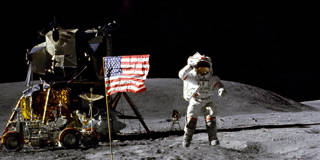A half-century after the first Moon landing, America’s triumph in the Space Race still stands out as an unparalleled feat of perseverance and ingenuity. Had advances in human space travel continued apace, there would almost certainly be human footprints on Mars, too.
CAMBRIDGE – I cannot look at the Moon without being reminded of July 20, 1969, when Neil Armstrong and Buzz Aldrin planted the first human footprints on its dusty surface. Then a young astronomer at the University of Cambridge, where the English astronomer Fred Hoyle was the top professor, I joined hundreds of millions of others around the world in witnessing grainy television images of that historic moment. When I met Fred the next day, he was enthralled. In addition to being a brilliant scientist, he was also an author of science fiction and had been anticipating this moment since his own childhood in the 1920s.
The exploit seems even more heroic in retrospect, given how “primitive” the technology was. Consider, for example, that NASA’s entire suite of computers was less powerful than a single smartphone today. Moreover, much of the crucial equipment going into the mission was not fully tested, including the Apollo Lunar Module (LM) that was needed to blast off from the moon’s surface with Armstrong and Aldrin for the return journey to the command module.
Given the risks, then-US President Richard Nixon’s speechwriter, William Safire, did the prudent thing and drafted a speech for a scenario in which the astronauts were left stranded. “Fate has ordained that the men who went to the moon to explore in peace will stay on the moon to rest in peace,” he wrote. “These brave men, Neil Armstrong and Edwin Aldrin, know that there is no hope for their recovery. But they also know that there is hope for mankind in their sacrifice.”

CAMBRIDGE – I cannot look at the Moon without being reminded of July 20, 1969, when Neil Armstrong and Buzz Aldrin planted the first human footprints on its dusty surface. Then a young astronomer at the University of Cambridge, where the English astronomer Fred Hoyle was the top professor, I joined hundreds of millions of others around the world in witnessing grainy television images of that historic moment. When I met Fred the next day, he was enthralled. In addition to being a brilliant scientist, he was also an author of science fiction and had been anticipating this moment since his own childhood in the 1920s.
The exploit seems even more heroic in retrospect, given how “primitive” the technology was. Consider, for example, that NASA’s entire suite of computers was less powerful than a single smartphone today. Moreover, much of the crucial equipment going into the mission was not fully tested, including the Apollo Lunar Module (LM) that was needed to blast off from the moon’s surface with Armstrong and Aldrin for the return journey to the command module.
Given the risks, then-US President Richard Nixon’s speechwriter, William Safire, did the prudent thing and drafted a speech for a scenario in which the astronauts were left stranded. “Fate has ordained that the men who went to the moon to explore in peace will stay on the moon to rest in peace,” he wrote. “These brave men, Neil Armstrong and Edwin Aldrin, know that there is no hope for their recovery. But they also know that there is hope for mankind in their sacrifice.”